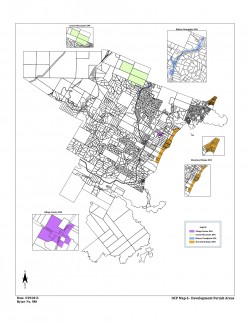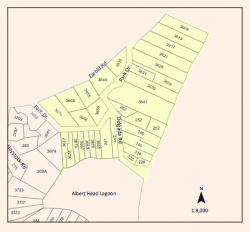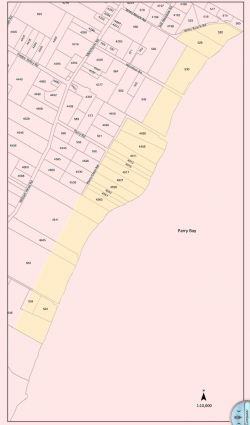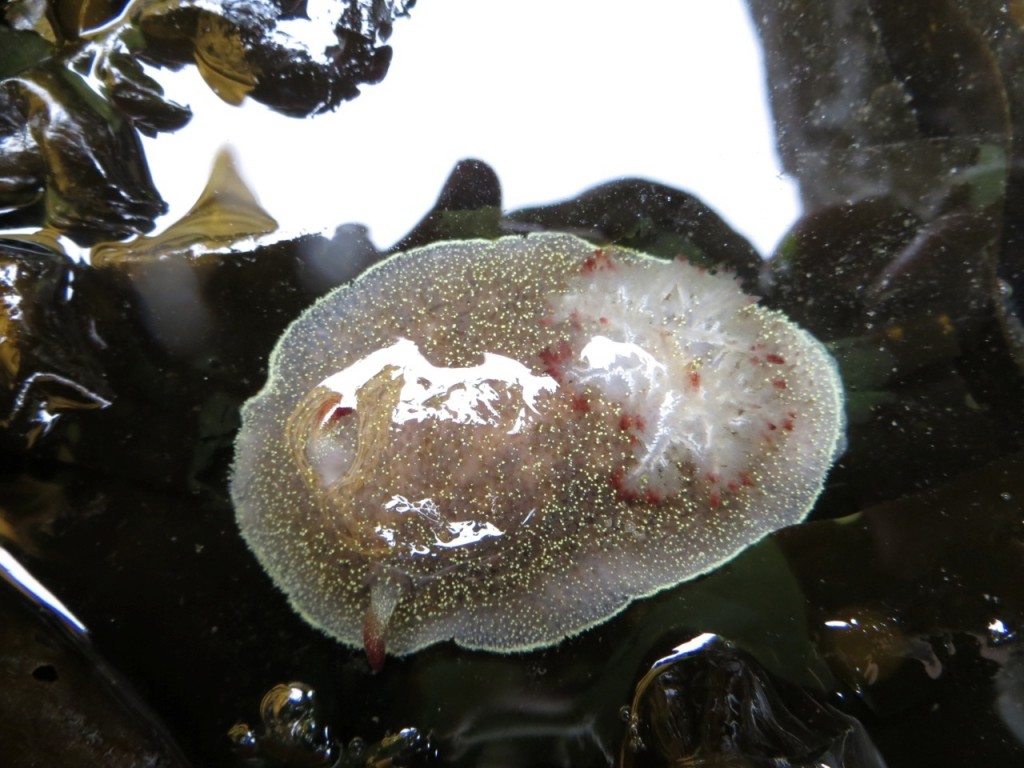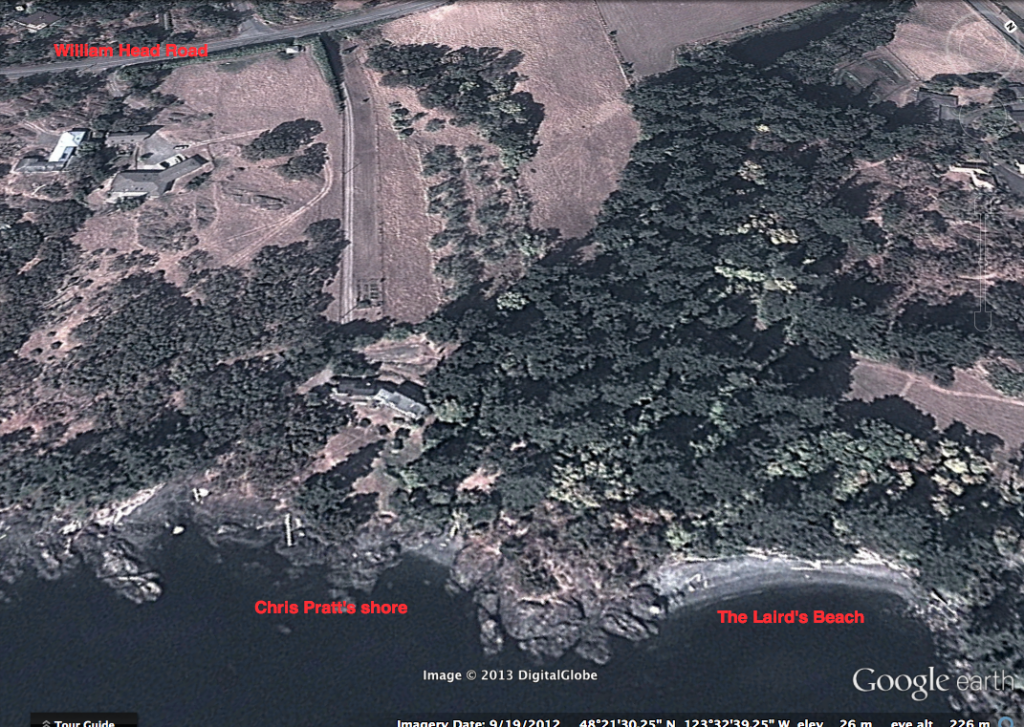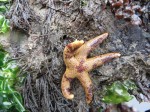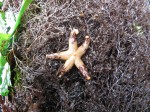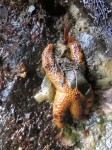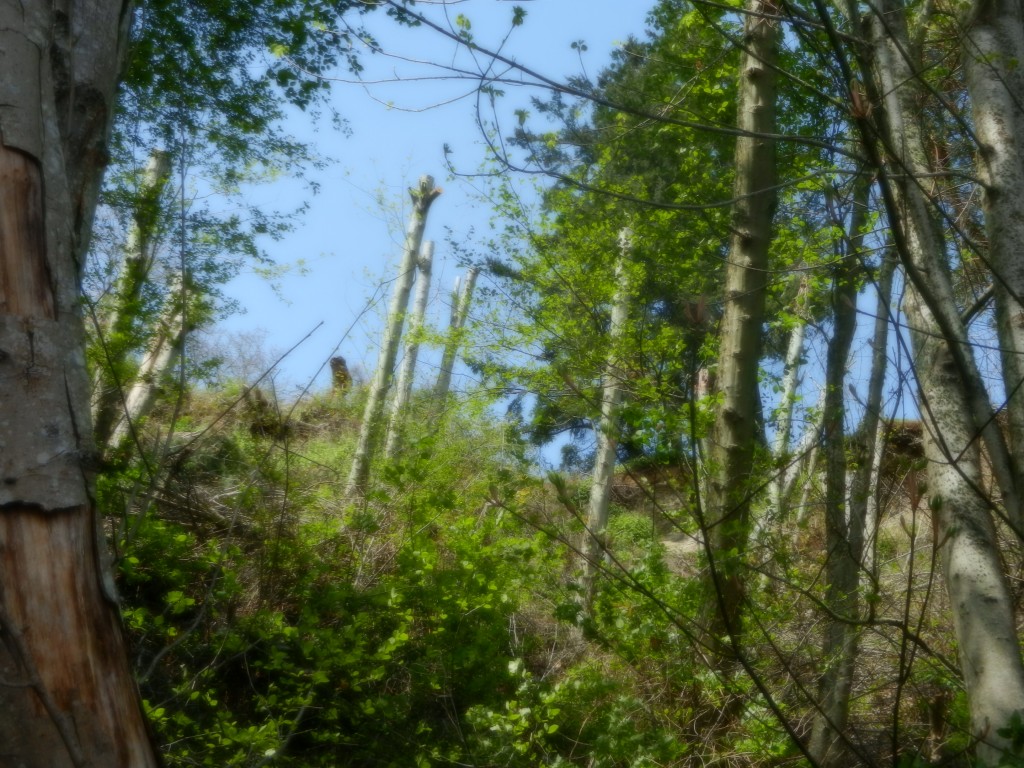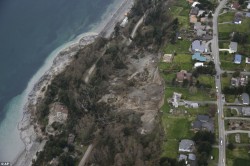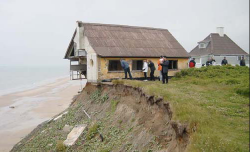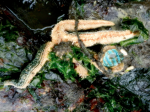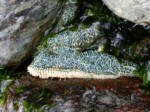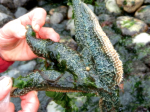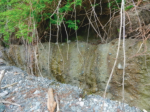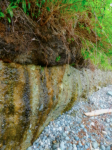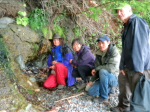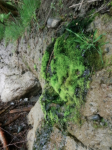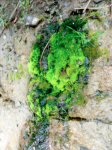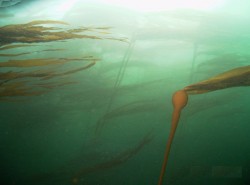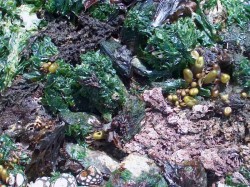Hardening of the Shorelines: Principles
The following is from :
Shorelines Modification , by the State of Washington Dept of Ecology
(ii) Principles. Shorelines are by nature unstable, although in varying degrees. Erosion and accretion are natural processes that provide ecological functions and thereby contribute to sustaining the natural resource and ecology of the shoreline. Human use of the shoreline has typically led to hardening of the shoreline for various reasons including reduction of erosion or providing useful space at the shore or providing access to docks and piers. The impacts of hardening any one property may be minimal but cumulatively the impact of this shoreline modification is significant.
Shoreline hardening typically results in adverse impacts to shoreline ecological functions such as:
- Beach starvation. Sediment supply to nearby beaches is cut off, leading to “starvation” of the beaches for the gravel, sand, and other fine-grained materials that typically constitute a beach.
- Habitat degradation. Vegetation that shades the upper beach or bank is eliminated, thus degrading the value of the shoreline for many ecological functions, including spawning habitat for salmonids and forage fish.
- Sediment impoundment. As a result of shoreline hardening, the sources of sediment on beaches (eroding “feeder” bluffs) are progressively lost and longshore transport is diminished. This leads to lowering of down-drift beaches, the narrowing of the high tide beach, and the coarsening of beach sediment. As beaches become more coarse, less prey for juvenile fish is produced. Sediment starvation may lead to accelerated erosion in down-drift areas.
- Exacerbation of erosion. The hard face of shoreline armoring, particularly concrete bulkheads, reflects wave energy back onto the beach, exacerbating erosion.
- Ground water impacts. Erosion control structures often raise the water table on the landward side, which leads to higher pore pressures in the beach itself. In some cases, this may lead to accelerated erosion of sand-sized material from the beach.
- Hydraulic impacts. Shoreline armoring generally increases the reflectivity of the shoreline and redirects wave energy back onto the beach. This leads to scouring and lowering of the beach, to coarsening of the beach, and to ultimate failure of the structure.
- Loss of shoreline vegetation. Vegetation provides important “softer” erosion control functions. Vegetation is also critical in maintaining ecological functions.
- Loss of large woody debris. Changed hydraulic regimes and the loss of the high tide beach, along with the prevention of natural erosion of vegetated shorelines, lead to the loss of beached organic material. This material can increase biological diversity, can serve as a stabilizing influence on natural shorelines, and is habitat for many aquatic-based organisms, which are, in turn, important prey for larger organisms.
- Restriction of channel movement and creation of side channels. Hardened shorelines along rivers slow the movement of channels, which, in turn, prevents the input of larger woody debris, gravels for spawning, and the creation of side channels important for juvenile salmon rearing, and can result in increased floods and scour.
Additionally, hard structures, especially vertical walls, often create conditions that lead to failure of the structure. In time, the substrate of the beach coarsens and scours down to bedrock or a hard clay. The footings of bulkheads are exposed, leading to undermining and failure. This process is exacerbated when the original cause of the erosion and “need” for the bulkhead was from upland water drainage problems. Failed bulkheads and walls adversely impact beach aesthetics, may be a safety or navigational hazard, and may adversely impact shoreline ecological functions.
“Hard” structural stabilization measures refer to those with solid, hard surfaces, such as concrete bulkheads, while “soft” structural measures rely on less rigid materials, such as biotechnical vegetation measures or beach enhancement. There is a range of measures varying from soft to hard that include:
- Vegetation enhancement;
- Upland drainage control;
- Biotechnical measures;
- Beach enhancement;
- Anchor trees;
- Gravel placement;
- Rock revetments;
- Gabions;
- Concrete groins;
- Retaining walls and bluff walls;
- Bulkheads; and
- Seawalls.
Generally, the harder the construction measure, the greater the impact on shoreline processes, including sediment transport, geomorphology, and biological functions.
District of Metchosin Official Community Plan Section on Shoreline Slopes Development Permit Areas
From the Official Community Plan : Available at this link
2.16 SHORELAND SLOPES DEVELOPMENT PERMIT AREAS:
The Municipal Act
provides that a community plan may designate development areas to be protected from hazardous conditions. The Municipal Act further provides that in such areas land shall not be altered in any way or subdivided and structures not be built or added to until a Development Permit has been issued. Council has established the following designation, special conditions, and guidelines.
2.16.1 Designation: (Bylaw 418, 2004)
The 1993 Hazard Land Management Plan has identified areas of the Metchosin shoreland slopes as having erosion, land sloughing and drainage problems.
The Shoreland Slopes areas are shown on Map 6 Shoreline Slopes DPA, and are hereby designated as areas for the protection of development from hazardous conditions pursuant to Section 919.1(1)(b) of the Local Government Act.
The Plan has identified three Shoreland Slope classification zones, based on the degree of slope instability and surface erosion potential. Slopes classified as zone 2 and 3 are slopes with the greatest potential for sloughing, slumping and debris flows and have been included in the Development Permit Area.
2.16.2 Special Conditions:
The major concern is that lands, particularly in the Park Drive – Farhill Road area, have experienced a dramatic rise in ground water levels due to adjacent developments during the last two decades. Other areas of the Shoreland slopes have experienced significant slope erosion in the past. There is a community desire to mitigate any further development related impacts on the marine shorelands.
2.16.3 Policies Development Permits issued shall be in accordance with the following:
(1) The construction or alteration of buildings on existing lots shall be permitted subject to the Building Permit process when Council is satisfied that the Development Permit Guidelines (Section 2.14.4) have been met, and, when required, Council is satisfied with the Engineer’s Report (Section 2.14.5).
(2)Where a Development Permit is applied for in conjunction with an application for subdivision approval, rezoning, or both, the Development Permit shall be conditional on the successful completion of those other permits and shall lapse if the subdivision or rezoning is not approved.
2.16.4 Guidelines:
(1) All applications for new development in the Development Permit Areas shall be required to have an Engineer’s Report (described below).
(2) Removal of vegetation shall be minimized.
(3) House construction, regrading, and excavation of till (including for road building) is not permitted within 60 metres of the edge of the slope except where geotechnical engineering and resource management studies indicate that a lesser setback is acceptable.
page 31
‐
2.16.5 Engineer’s Report:
Before a development permit is issued, the applicant shall be required to furnish a report at his\her expense from a registered professional engineer with geotechnical experience which will certify that the proposed development will produce no adverse impacts on the shoreland slopes and will not place buildings or structures in danger of slope slippage.
The Engineer’s Report shall demonstrate that consideration has been given to the following:
(1)(a) siting and setbacks of development structures, roads, and services,
(b) minimizing paving and impervious materials, and,
(c) implementing infiltration techniques so as to limit runoff;
(2) designing runoff detention ponds, drainage works, or
sediment traps or basins to reduce the flow of runoff and silt during land clearing and construction.
(3) development near shoreland slopes must address the impact of surface water on slope stability, vegetation and soils, and make recommendations to remedy that already damaged; and
(4) removal of trees (with a valid tree-cutting permit) or other vegetation should be allowed only where necessary and where alternate vegetation and/or erosion control measures are established. If possible, stumps should be left in place to provide some soil stabilizing influence until alternative vegetation is established. Plans delineating extent of vegetation/tree removal (location, species and diameter of trees) and location of proposed construction, ex cavation and/or blasting, may be required.
The DISTRICT, at its discretion, may also submit the Engineer’s Report to review by a second Engineer at the applicant’s expense, and/or directly to the Ministry of Environment for their comments.
2.16.6 Municipal Response,
The DISTRICT should:
(1) evaluate the feasibility of purchasing environmentally sensitive shorelands for use as park, forest reserve, or greenbelt;
(2) initiate programs to monitor both surface and ground water to establish patterns of change;
(3)work with proximate agencies to establish erosion and land sloughing control measures.
Acanthodoris nanaimoensis–the wine-plumed spiny dorid nudibranch
On May 26 2013, Gretchen Markle reported on a nudibrach
” Today we found two specimens of the grey phase Acanthodoris nanaimoensis (unmistakable with its maroon-tipped rhinopores and gills) on the beach at Chris Pratt’s.” (see location image below.)
The range of this species is Baranof Island, Alaska to Santa Barbara, CA; less common in southern portion of range.
Click on this image from Google Earth 3D for the location.
Henricia pumila–dwarf mottled Henricia
Gretchen Markle reported a new seastar Henricia pumila for the April 27 Metchosin Bioblitz on the Laird’s beach , south of Taylor Road and north off Weir’s beach (see Google image below). Henricia pumila is an uncommon seastar, having only been officially described in 2010. Phil Lambert confirmed the identification.
See http://www.mapress.com/
- Henricia pumila ,Eernisse et al., 2010 Dwarf mottled henricia
- Photos of H.pumila by Gretchen Markel
- Henricia pumila on Chris Pratt’s Beach
Phylum Echinodermata
Class Asteroidea
Order Spinulosida
Suborder Leptognathina
Family Echinasteridae
Genus Henricia
Species pumila, Eernisse et al., 2010
Common name: Dwarf mottled henricia.
Anything for a View?
Living on a steep coastal bluff with million dollar views may be a dream of many, but with it comes a few responsibilities. The references on development along coastal areas provides many examples of how development has to be done responsibly. One aspect of concern is vegetation removal and tree cutting and topping on cliffs in order to provide better views to the landowner. In Metchosin, two areas, the Albert Head Cliffs and the Taylor Beach Cliffs provide many examples of this.
In April of 2013 the sound of a chainsaw on the Taylor cliffs led to the discovery of many alder trees on the almost vertical slope that had been topped and even a few arbutus trees had been cut down.
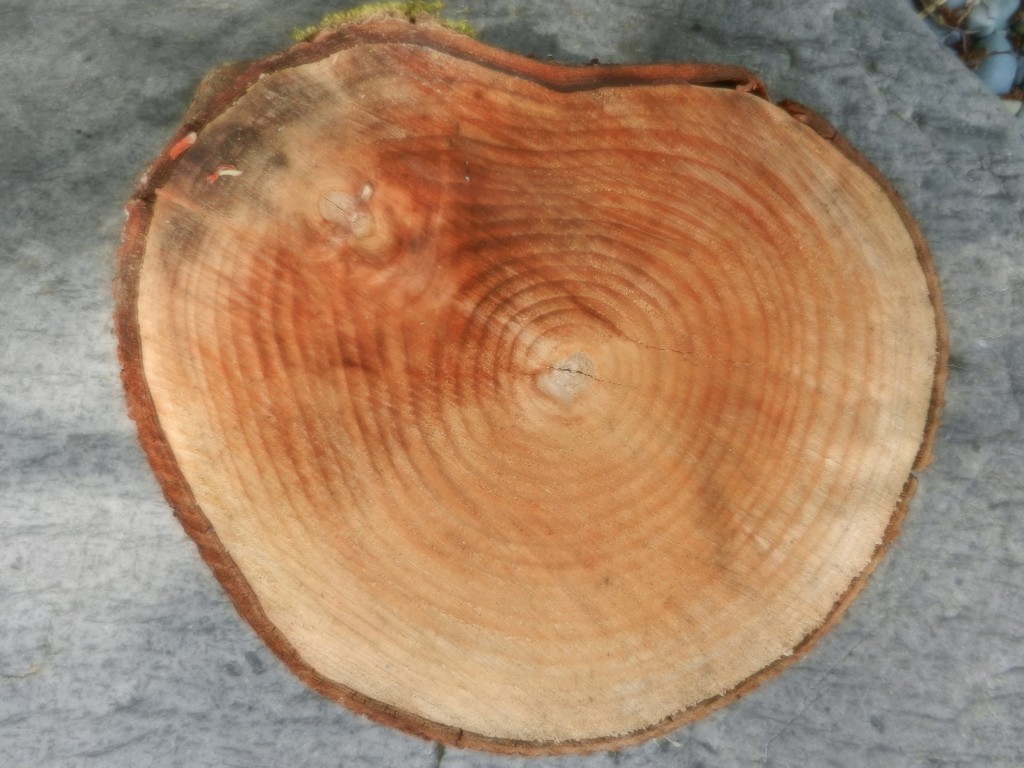 These trees were about 25 years old as can be seen by the tree rings on chunks of trees that had rolled down to the beach.
These trees were about 25 years old as can be seen by the tree rings on chunks of trees that had rolled down to the beach.
It might be pointed out that these trees are from the area of Metchosin’s Coastline included in the development permit zone.
This reference from the Center for Ocean Solutions points out he problems of interferring with natural processes on an seaside cliff given the threats of climate change and sea level rise.
A good example taken from “Mail Online” of what slope failure looked like on Whidbey Island.
Evasterias troscheli–mottled star
These photos taken by Garry Fletcher on the rocky intertidal at the base of Taylor Bluffs on Parry Bay shows an unusual green phase of the Evasterias troscheli
- The sea star Evasterias eating Mopalia chitons.
- A green version of the mottled star, Evasterias sp.
| Kingdom: Animalia |
| Phylum: Echinodermata |
| Subphylum: Eleutherozoa |
| Superclass: Asterozoa |
| Class: Asteroidea |
| Order: Forcipulatida |
| Family: Asteriidae |
| Genus: Evasterias |
| Species: E. troscheli |
| Binomial name: Evasterias troscheli, (Stimpson, 1862) |
Metchosin Bioblitz 2013: North end of Sector 7, Taylor Beach
Metchosin BioBlitz Observations by Garry Fletcher and Sandra______on April 27, 2013 on the floodplane and estuary of Gooch Creek, on the 4645 William Head Road Property.
- Vertical erosion bank at toe of bluffs
- Fresh water seeps at base of cliff
- Team of Bryologists and Kem Luther examining habitat of Crumia sp.
- Mosses growing in Fresh water seep.
- The mosses Pholia sp.and Crumia sp.
- Mute swans– feed off Taylor beach , nest in Sherwood pond.
Metchosin Bioblitz 2011-2012 lists for Sector 7, Weir’s Beach to Taylor Beach Bluffs
 Sector 7. Weirs and Taylor Beach Bluffs – A variety of cliff face, beach, estuary and rocky shores, with intertidal areas.
Sector 7. Weirs and Taylor Beach Bluffs – A variety of cliff face, beach, estuary and rocky shores, with intertidal areas.
Thanks to Kem Luther for providing the Metchosin Bioblitz Records for this Coastal Sector and to the individuals who examined the area on the day of the Bioblitz , in April, 2012
| Species | Common name | Species-Group | sub-group | |
| Acrosiphonia coalit | Greenrope | Algae | chlorophyta | |
| Alaria marginata | brown algae | Algae | paheophyta | |
| Costaria costata | Five-ribbed kelp | Algae | phaeophyta | |
| Cystoseira sp | Bladder Leaf | Alga | phaeophyta | |
| Enteromorpha intestinalis | Tube weed | Algae | chlorophyta | |
| Fucus sp. | Rockweed | Algae | phaeophyta | |
| Lithothamnion sp. | re encrusting | Algae | rhodophyta | |
| Mazaella sp. | Iridescent red algae | Algae | rhodophyta | |
| Scytosiphon lomentaria | Soda Straw | Algae | phaeophyta | |
| Stephanocystis geminata | Algae | phaeophyta | ||
| Ulva lactuca | Sea lettuce | Algae | chlorophyta | |
| Leucolepis acanthoneuron | Palm tree moss | Bryophyte | Moss | moist, rich site |
| Rhytidiadelphus triquetrus | Cat’s paw moss | Bryophyte | Moss | moist, rich site |
| Balanus crenatus | Crenate barnacle | Invertebrate | Arthropod | |
| Balanus glandula | Acorn barnacle | Invertebrate | Arthropod | |
| Cancer magister | Dungeness crab | Invertebrate | Arthropod | |
| Cancer productus | Red rock crab | Invertebrate | Arthropod | |
| Caprella sp. | Skeleton shrimp | Invertebrate | Arthropod | |
| Chromopleustes oculatus | Black and White Sea Flea | Invertebrate | Arthropod | |
| Chthamalus dalli | Little brown barnacle | Invertebrate | Arthropod | |
| Crangon alaskensis | Northern Crangon | Invertebrate | Arthropod | |
| Gnorimosphaeroma oregonense | Stubby Isopod | Invertebrate | Arthropod | |
| Hemigrapsus nudus | Purple Shore Crab | Invertebrate | Arthropod | |
| Heptacarpus spp | Shrimp | Invertebrate | Arthropod | |
| Idotea wosnesenskii | Rockweed isopod | Invertebrate | Arthropod | |
| Pagurus hirsutiusculus | Hairy hermit crab | Invertebrate | Arthropod | |
| Petrolisthes eriomerus | Flattop crab | Invertebrate | Arthropod | |
| Pugettia gracilis | Graceful kelp crab | Invertebrate | Arthropod | |
| Semibalanus cariosus | Thatched barnacle | Invertebrate | Arthropod | |
| Spirontocaris sp | Shrimp | Invertebrate | Arthropod | |
| Anthopleura elegantissima | Aggregating anemone | Invertebrate | Cnidaria | |
| Urticina crassicornis | Painted Anemone | Invertebrate | Cnidaria | |
| Evasterias troschelli | Mottled Star | Invertebrate | Echinoderm | |
| Pycnopodia helianthoides | Sunflower Star | Invertebrate | Echinoderm | |
| Clinocardium nuttallii | Nuttall’s Cockle | Invertebrate | Mollusc | |
| Littorina scutulata | Checkered Periwinkle | Invertebrate | Mollusc | |
| Littorina sitkana | Sitka Periwinkle | Invertebrate | Mollusc | |
| Lottia digitalis | Finger limpet | Invertebrate | Mollusc | |
| Lottia pelta | Shield Limpet | Invertebrate | Mollusc | |
| Macoma nasuta | Bent-nose macoma | Invertebrate | Mollusc | |
| Macoma secta | White Sand Macoma | Invertebrate | Mollusc | |
| Mopalia liignosa | Woody Chiton | Invertebrate | Mollusc | |
| Mopalia muscosa | Mossy Chiton | Invertebrate | Mollusc | |
| Mytilus trossulus | Pacific Blue Mussel | Invertebrate | Mollusc | |
| Nucella lamellosa | Wrinkled Dogwinkle | Invertebrate | Mollusc | |
| Nucella ostrina | Northern Striped Dog Winkle | Invertebrate | Mollusc | |
| Nuttallia obscurata | Dark Mahogany Clam | Invertebrate | Mollusc | |
| Rostanga pulchra | Red Nudibranch | Invertebrate | Mollusc | |
| Tectura persona | Mask Limpet | Invertebrate | Mollusc | |
| Tectura scutum |
Shield limpet | Invertebrate | Mollusc | |
| Tonicella lineata | Lined Chiton | Invertebrate | Mollusc | |
| Eudistylia vancouveri | Feather duster worm | Invertebrate | Polychaete | |
| Schizobranchia sp. | Feather duster worm | Invertebrate | Polychaete | |
| Thelepus sp | Spaghetti worm | Invertebrate | Polychaete | |
| Halichondria sp. | Yellow encrusting sponge | Invertebrate | Porifera | |
| Ophlitaspongia pennata | Red Encrusting Sponge | Invertebrate | Porifera | |
| Pyura haustor | Warty Tunicate | Invertebrate | Tunicate | tunicate, not in ef |
| Peltigera aphthosa | Rock lichen | Lichen | xeric (rock) | |
| Pentagramma triangularis | Goldenback fern | Vascular plant | Fern | sub-xeric |
| Polystichum munitum | Sword fern | Vascular plant | Fern | scattered |
| Pteridium aquilinum | Bracken fern | Vascular plant | Fern | disturbed ground |
| Achillea millefolium | yarrow | Vascular plant | Forb | |
| Alyssum sp. | Alyssum | Vascular plant | Forb | |
| Ambrosia chamissonis | Silver burr ragweed | Vascular plant | For | adjacent to beac |
| Angelica sp. | sea-watch? | Vascular plant | Forb | |
| Aquilegia formosa | Columbin | Vascular plant | Forb | scattered |
| Brassica campestris | Fieldnmustard | Vascular plant | Forb | scatteredn |
| Cardamine oligosperma | Few-seeded bitter-cress | Vascular plant | Forb | mesic |
| Chenopodium album | Lamb’s-quarters | Vascular plant | Forb | open, disturbed a |
| Cirsium edule | Edible thistle | Vascular plant | Forb | toe slopes, expo |
| Claytonia perfoliata | Miner’s lettuce | Vascular plant | Forb | sub-hygric |
| Epilobium angustifolium | Fireweed | Vascular plant | Forb | base of bluffs |
| Equisetum arvense | Horsetail | Vascular plant | Forb | sandy wet sites |
| Erodium cicutarium | stork’s bill | Vascular plant | Forb | |
| Galium aparine | Cleavers (bedstraw) | Vascular plant | Forb | toe of bluffs |
| Geranium molle | dove’s foot geranium | Vascular plant | Forb | |
| Geranium robertianum | Herb-Robert | Vascular plant | Forb | toe of bank |
| Geum macrophyllum | Large-leaved avens | Vascular plant | Forb | permesic |
| Heracleum maximum | cow-parsnip | Vascular plant | Forb | |
| Heuchera micrantha | Small flowered alumroot | Vascular plant | Forb | occasional |
| Hyacinthoides sp. | bluebells | Vascular plant | Forb | |
| Hyacinthus orientalis | Hyacinth | Vascular plant | Forb | escaped exotic |
| Hypochaeris radicata | Hairy catsear | Vascular plant | Forb | mesic |
| Lamium purpureum | purple dead nettle | Vascular plant | Forb | |
| Lathyrus japonicus | Beach pea | Vascular plant | Forb | open toe slope, a |
| Linnaea borealis | Twinflower | Vascular plant | Forb | shaded forest |
| Lithophragma parviflorum | Small-flowered woodland star | Vascular plant | Forb | occasional |
| Lysichiton americanus | Skunk cabbage | Vascular plant | Forb | on Garry Fletcher’s |
| Maianthemum dilatatum | False lily of the valley | Vascular plant | Forb | on Garry Fletcher’s |
| Medicago lupulina | Black medic | Vascular plant | Forb | disturbed site |
| Mitella brewerii | Brewer’s mitrewort | Vascular plant | Forb | occasional |
| Oenanthe sarmentosa | Pacific water-parsley | Vascular plant | Forb | sub-hygric |
| Osmorhiza chilensis | sweet-cicely | Vascular plant | Forb | |
| Phragmites australis | Common reed | Vascular plant | Forb | open wet meado |
| Plantago sp. | plantain | Vascular plant | Forb | |
| Platanthera sp. | rein orchid | Vascular plant | Forb | |
| Potentilla anserina | silverweed | Vascular plant | Forb | |
| Potentilla anserina | Common silverweed | Vascular plant | Forb | marsh adjacent t |
| Prunella vulgaris | Self-heal | Vascular plant | Forb | moist microsite |
| Ranunculus occidentalis | Western buttercup | Vascular plant | Forb | open areas |
| Ranunculus sp. | buttercups | Vascular plant | Forb | |
| Ranunculus uncinatus | Small-flowered buttercup | Vascular plant | Forb | openings next to |
| Romanzoffia tracyi | Tracey’s mistmaiden | Vascular plant | Forb | |
| Rumex acetosella | sheep sorrel | Vascular plant | Forb | |
| Rumex sp. | dock | Vascular plant | Forb | |
| Saxifraga sp. | Saxifrage | Vascular plant | Forb | |
| Senecio vulgaris | Common groundsel | Vascular plant | Forb | mesic |
| Sonchus asper | Prickly sow thistle | Vascular plant | Forb | not in flower |
| Stachys sp. | hedge nettle | Vascular plant | Forb | |
| Taraxacum officinale |
Common dandelion | Vascular plant | Forb | adjacent to beac |
| Taraxacum sp. | dandelion | Vascular plant | Forb | |
| Tellima grandiflora | Fringe cup | Vascular plant | Forb | permesic, base o |
| Trientalis borealis ssp latifolia | Starflower | Vascular plant | Forb | permesic |
| Trifolium repens | White clover | Vascular plant | Forb | shady, moist site |
| Urtica dioica | stinging nettle | Vascular plant | Forb | |
| Vicia sativa | Common vetch | Vascular plant | Forb | disturbed sites |
| Elymus mollis | Tall beachgrass | Vascular plant | Grass | next to the beach |
| Poa sp. | Bluegrass | Vascular plant | Grass | scattered |
| Juncus effusus | Common rush | Vascular plant | Rush | on Garry Fletcher’s |
| Carex lyngbyei | Lyngby’s sedge | Vascular plant | Sedge | on Garry Fletcher’s |
| Carex obnupta | Slough sedge | Vascular plant | Sedge | on Garry Fletcher’s |
| Scirpus americanus |
Hard-stemmed bullrush | Vascular plant | Sedge | on Garry Fletcher’s |
| Amelanchier alnifolia | Saskatoon berry/service berry | Vascular plant | Shrub | |
| Cytisus scoparius | Scotch broom | Vascular plant | Shrub | in open areas (in |
| Daphne laureola | spurge-laurel | Vascular plant | Shrub | scattered along b |
| Gaultheria shallon | salal | Vascular plant | Shrub | |
| Hedera helix | English ivy | Vascular plant | Shrub | naturalized |
| Holodiscus discolor | ocean spray | Vascular plant | Shrub | |
| Ilex sp | Holly | Vascular plant | Shrub | naturalized |
| Lonicera ciliosa | orange honeysuckle | Vascular plant | Shrub | |
| Mahonia nervosa | Oregon grape | Vascular plant | Shrub | drier sites |
| Oemleria cerasiformis | Indian plum | Vascular plant | Shrub | mesic and wetter |
| Ribes lacustre | Black gooseberry | Vascular plant | Shrub | toe slopes |
| Ribes sanguineum | Red flowering currant | Vascular plant | Shrub | toe slopes |
| Rosa nutkana | Nootka rose | Vascular plant | Shrub | |
| Rubus armeniacus | Himalayan blackberry | Vascular plant | Shrub | exposed areas (i |
| Rubus parviflorus | thimble berry | Vascular plant | Shrub | |
| Rubus spectabilis | salmon berry | Vascular plant | Shrub | |
| Rubus ursinus | Trailing blackberry | Vascular plant | Shrub | in openings near |
| Sambucus racemosa | red elder | Vascular plant | Shrub | |
| Symphoricarpos albus | snowberry | Vascular plant | Shrub | |
| Ulex europaeus | Gorse | Vascular plant | Shrub | introduced |
| Abies grandis | grand fir | Vascular plant | Tree | |
| Acer macrophyllum | big leaf maple | Vascular plant | Tree | |
| Alnu rubra | red alder | Vascular plant | Tree | |
| Arbutus menziesii | arbutus | Vascular plant | Tree | |
| Malus fusca | Pacific crabapple | Vascular plant | Tree | permesic site |
| Pinus contorta | shore pine | Vascular plant | Tree | |
| Prunus marginata | Bitter cherry | Vascular plant | Tree | permesic site |
| Pseudotsuga menziesii | Douglas fir | Vascular plant | Tree | |
| Quercus garryana | Garry Oak | Vascular plant | Tree | |
| Salix scouleriana | Scouler’s willow | Vascular plant | Tree | above the beach |
| Salix sitchensis | Sitka willow | Vascular plant | Tree | adjacent to the b |
| Salix sp. | willow | Vascular plant | Tree | |
| Buteo jamaicensis | Red tail hawk | Vertebrate | Bird | in the air above T |
| Haliaeetus leucocephalus | Bald eagle | Vertebrate | Bird | in the air east of |
| Larus glaucescens | Glaucus winged gull | Vertebrate | Bird | in the air numer |
| Sphyrapicus ruber | Red-naped sapsucker | Vertebrate | Bird | in an alder snag |
| Blepsias cirrhosus | Silverspotted Sculpin | Vertebrate | Fish | |
| Gobiesox maeandricus | Northern Clingfish | Vertebrate | Fish | |
| Leptocottus armatus | Staghorn Sculpin | Vertebrate | Fish | |
| Liparis florae | TidepoolSnailfish | Vertebrate | Fish | |
| Pholis sp. | Gunnel | Vertebrate | Fish | |
| Lontra canadensis | River otter | Vertebrate | Mammal | off Witty’s beach |
| Oryctolagus cuniculus | European rabbit | Vertebrate | Mammal | open grass mead |
| Phoca vitulina | Harbour seal | Vertebrate | Mammal | |
| Thamnophis sp | Garter snake | Vertebrate | Reptile | in the grass adjacent |
Macroalgae ( Kelp) beds around Southern Vancouver Island and their role in Carbon Sequestration .
Sometimes viewed as a nuisance for boaters around the shores of Metchosin, kelp beds (Nereocystis luetkeana) are however a valuable species of our natural capital
Our kelp beds provide ecosystem services such as habitat for juvenile fish, and marine mammals. Research on macroalgae of the temperate coastal areas in the world has also shown extremely high rates of photosynthetic capacity and therefore another ecosystem service, in these algal beds, carbon fixation, In this post I will annotate some of the significant research that documents the value of this resource.
“Kelp forests occur in cold, nutrient-rich water and are among the most beautiful and biologically productive habitats in the marine environment. They are found throughout the world in shallow open coastal waters, and the larger forests are restricted to temperatures less than 20ºC, extending to both the Arctic and Antarctic Circles. A dependence upon light for photosynthesis restricts them to clear shallow water and they are rarely much deeper than 15-40m. The kelps have in common a capacity for some of the most remarkable growth rates in the plant kingdom. In southern California, the Macrocystis can grow 30 cm per day.”
- Using marine macroalgae for carbon sequestration: a critical appraisal.
Ik Kyo Chung et al. J Appl Phycol ( 2011)23:877-886
Abstract: There has been a good deal of interest in the potential of marine vegetation as a sink for anthropogenic carbon emissions , (Blue Carbon). Marine primary producers contribute at least 50% of the world’s carbon fixation and may account for as much as 71 percent of all carbon storage. In this paper, we analyze the current rate of harvesting of both commercial and growing and wild growing macro algae, as well as their capacity for photosynthetically driven carbon dioxide assimilation and growth. We suggest that carbon dioxide acquisition by marine macroalgae can represent a considerable sink for anthropogenic carbon dioxide emissions and the harvesting and appropriate use of macroalgal primary production could play a significant role in carbon sequestration and amelioration of greenhouse gas emissions.
___________________________________________
Off the shores of Weir’s Beach grows a large bed of Sea lettuce (Ulva lactuca) . the following article attests to the efficiency of sea lettuce in carbon dioxide fixation:
Carbon sequestration by a few marine algae: observation and projection
Kaladharan, P and Veena, S and Vivekanandan, E (2009) Carbon sequestration by a few marine algae: observation and projection. Journal of the Marine Biological Association of India, 51 (1). pp. 107-110
Abstract: CO2 sequestration by the marine planktonic microalgae Nannochloropsis salina and Isochrysis galbana as well as macroforms Gracilaria corticata, Sargassum polycystum and Ulva lactuca was estimated under laboratory conditions. The green seaweed U. lactuca registered 100% utilization of CO2 towards carbon fixation from the ambient water up to 15 mg/l and beyond that it declined to 60%. The microalgae were able to utilize 27.7% of dissolved CO2 at 15 mg/l, but did not show any effect either for carbon fixation or for emission at lower and higher levels. Gross primary productivity of these algae were also not affected by increase in the CO2 levels. It is estimated that the seaweed biomass along the Indian coast is capable of utilizing 9052 tCO2/d against emission of 365 tCO2 /d indicating a net carbon credit of 8687 t/d.
- A detailed mapping of Nereocystis beds and Ulva lactuca beds on the Coast of Metchosin should be done to quantify the extent of these resources.
________________________________________________________________
Concerns for the Kelp Resources of Metchosin:
Both the stipe and the blades of Nereocystis luetkeana are used for fresh and dried foods, nutritional supplements, cosmetic products such as exfoliants, fertilizers, animal feed, dog snacks, and dog shampoo and moisturizer. Producers have found that it is rich in calcium, magnesium, sodium, iodine, potassium, phosphorus, iron, bulk fiber, and vitamins A, B complex, C, D, E, and K, protein and free amino acids. It is used as an herbal remedy, with claims that it detoxifies body tissues of heavy metal and radioactive agents, treats thyroid disorders, arthritis and digestive problems; purifies blood, aids in weight loss, eases lymphatic swelling; treats herpes infections, eases inflammation and neuritis, soothes mucuous membranes, and reduces side effects of chemotherapy and radiation. Other benefits mentioned for Nereocystis luetkeana in the spa include that it is stimulating, firming, revitalizing, tonic and slimming. Over 25 products have been identified from over 10 different sellers in Canada, the United States, and the Netherlands.
Commercial harvesting is known to occur in British Columbia and California
As Nereocystis luetkeana grows in the subtidal and shallow intertidal zones, it is typically harvested from a skiff or small boat with a knife, although in some areas it may be harvested on foot at low tide.
Nereocystis tends to grow in large kelp forests, and the blades create lush surface canopies. Kelp forests provide important sheltering habitat for many marine fishes and invertebrates, including urchins, sea stars, snails and crabs, and are an important food source for sea urchins. These forests also provide habitat for sea otters since sea otters eat the invertebrates that live on the kelp forest floor and the kelp itself provides a canopy which the otter can anchor to while resting to keep from drifting away. The anchoring holdfast can reach a diameter of more that a foot, and can harbor its own collection of organisms by offering them protection among the haptera. Nereocystis luetkeana is the only kelp which will drop spore patches, so that the right concentration of spores lands near the parent’s holdfast. They grow out continuously from a meristem located at their base and slough off at their older outer tips. The detritus formed by the sloughing tips has been shown to be an important source of carbon for inshore intertidal communities. This detritus feeds species such as Blue rockfish (Sebastes mystinus) and many of the filter feeders, such as Pacific Blue Mussels (Mytilus trossulus) in the intertidal zone. Urchins feed on Nereocystis luetkeana, and conversely this kelp can opportunistically and rapidly colonize areas that have been cleared by urchins.”
_______________________________________________________________
Research into the role of marine algae and its importance in contributing to energy flow when they end up on a beach is reported in the following research out of the Bamfield Marine Station:
- Recommendation: The municipality should investigate the possibility of influencing provincial legislation to place a moratorium on the harvest of any natural kelp resources on our shoreline.

